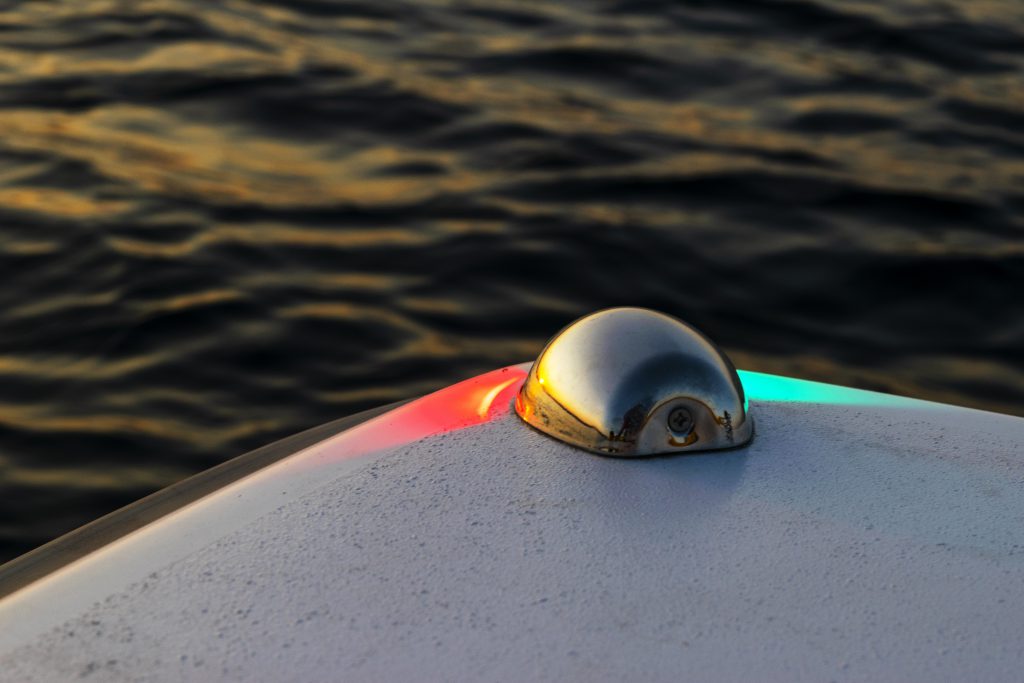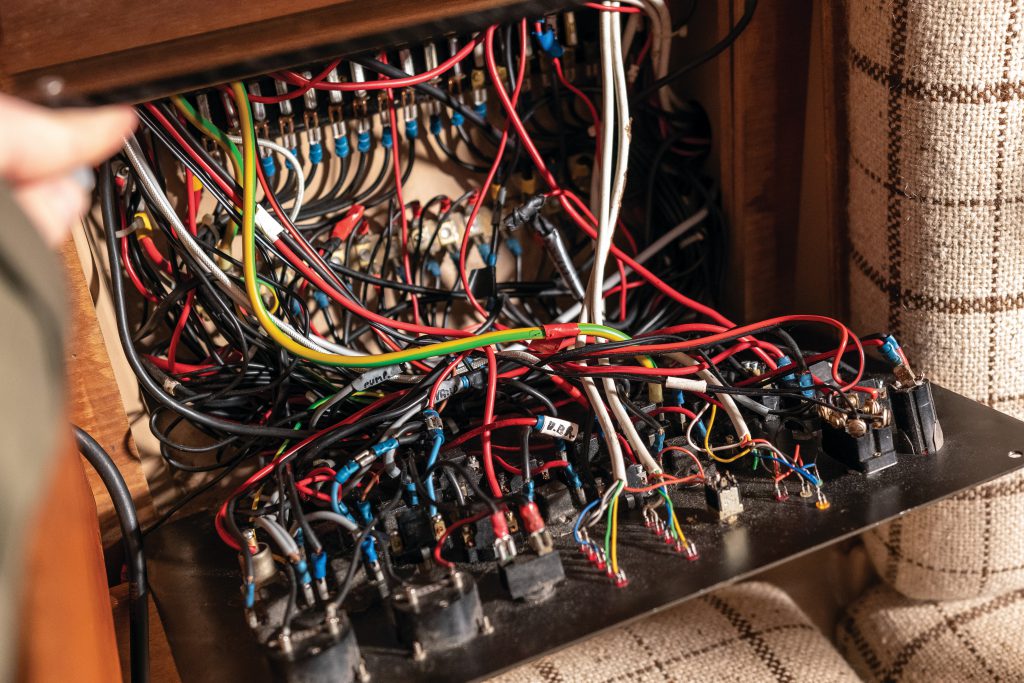Why are My Lights Dim?
November 24th, 2021 by team

by B.J. Porter (Contributing Editor)
Every boat big enough for running lights has an electrical system. And every boat owner with an electrical system should understand the basics of electricity. You don’t need to know how to build an alternator out of refrigerator magnets, a water pump, and a pine cone like some nautical MacGyver, but you should understand a few of the why’s and how’s of one of your boat’s most important systems.
Why, you might ask? Most people leave this stuff to the yards, right?
The yard guys aren’t coming sailing with you, and they won’t be using your boat. A good electrical system is for comfort and safety. If you don’t understand the limitations of your boat, you’ll struggle to get the most of it, and you may even be a danger to yourself and others.

The Basics – Current, Voltage, and Power
The language of electricity has a few terms you need to know. Once you learn them and how they relate to each other, you’ll be able to see into your boat’s electrical system and learn what works and what doesn’t. To illustrate these ideas, we’ll use the very unoriginal analogy of pipes, hoses, and water flow because it’s an analogy that’s easy to understand and reasonably accurate.
The most common electrical term you’ll hear is Voltage, as in “that boat has a 12 Volt system.” Voltage is equivalent to the water pressure or driving force behind the water at the faucet. It’s the potential energy in a system, measured by the voltage difference from the start to finish.
Electric devices need to match source power voltage. The wrong voltage may damage a device, or it won’t work as well as it’s supposed to.
Current is the flow of electricity, and is measured in Amperes, commonly shortened to Amp. In equations, the letter “I” refers to current.
Current is the flow of electricity, not unlike the flow of water. It’s measured in Amperes, usually shortened to Amps. It’s important to remember than all Amps are not created equal and should not be used as the primary measure for power.
We express Power in Watts. Power is how much work you can do with that current. Then analog is the total amount of water that comes through your system. Power is the current multiplied by the voltage. Amps x Volts = Watts.
From this formula, you can see that if you double the voltage, you’ll double the power. So a two Amp load in a 24V system has the same power as a four Amp load at 12 Volts.
The other measure of power used in boat electrical systems is a unit of power over time, expressed typically as Amp-hours or Watt-hours. This is the total amount of power the device can deliver as it’s used, whether it’s a high load over an hour or a load over many hours. So a 50 Amp-hour (or “Ah”) battery should theoretically deliver 2.5 Amps for 20 hours, 5 Amps for 10 hours, or 50 Amps for an hour before discharge – any combination where Amps x Time = 50 Ah.

So Why are My Lights Dim?
Most people today travel with a lot of electrical gadgets and power consuming devices. When I first starting running laptops on boats, I noticed a big change in power consumption. The next thing I knew, we didn’t have power to keep the refrigerator running through the weekend any more. Why did this start happening?
The answer lies in the capacity of the various batteries on board and how you are consuming power on your boat. For this, we need to do a little math.
If you don’t know what size and power batteries you have on your boat, you should.
Capacity Example
A typical 12V “Group 31” (a common battery size on 30-40 foot boats) deep cycle battery has around 100 Amp-hours of capacity. You can discharge batteries of this type to 50% full without damage, so you’ve got 50Ah of usable power in regular use.
A small refrigeration system may drain 4 amps when it’s running, but only cycle on for about 25% of the time. So in every hour, it’s using about one Amp-hour of power (4 Amps x 25% x 1 Hour), which is about half the usable capacity of that battery per day (1 amp x 24 hours = 24 Ah). If you start a weekend with your batteries full, you may make it until Sunday morning without charging.
Add a Laptop
Now let’s take your laptop and plug it into an inverter on a 12V socket and watch some movies. The plug block on your laptop says it uses up to 65 Watts of power maximum plugged into a 110V socket.
Remember the equation Watts = Volts x Current?
If we rearrange that formula to solve for current, we get:
Current = Watts/Volts
The inverter is drawing 12V power from the lighter socket. It loses some power to inefficiency running the laptop, but we can ignore that for clarity.
Let’s plug in the voltage and get the current the laptop pulls from the battery:
Current = 65 Watts/12V
Current = 5.4 Amps
If you watch one two-hour movie, you can consume almost 11 Amps – 20% of your usable power – in one sitting. Binge a series for a few hours and you’ll need to recharge before the next cocktail hour.
In the meantime, the lights may dim as the battery discharges. When battery gets too low, electronics may not work. If your anchor light gets too dim to see in the middle of the night, you have a safety issue.
Modern Problems
We’re pretty power hungry today. Everyone has a phone or a tablet, and kids love portable gaming. It’s almost a guarantee you’ll always want more power than you have, and you’ll hit your boat’s power harder than you expect.
Keeping the Lights Bright

There are a few steps you can take to get more out of your battery capacity and keep your boat running all weekend or through your vacation. Some are behavioral, some are changes and upgrades to the boat.
A few free tips to help you right away –
- Watch your plug-ins. On a boat with small batteries, charge your devices before you come on the boat and use them on battery until they’re discharged.
- Recharge your devices when you’re charging the ship’s batteries. Your boat batteries will charge when the engine is on. But charging your laptop and devices in when the engine is off will drain the house battery. Wait to charge devices until the engine is running and you can tap some of that charge power when it’s being made. If you use the laptop’s battery to watch a movie instead of plugging it in, you can charge it up the next time you’re moving the boat and it will take nothing from the batteries.
- Remember getting yelled at as a kid when you left the lights on? Your mom was right…be militant about turning everything you’re not using off.
Boat upgrades cost money, but if you find yourself in the dark with warm drinks on too many weekends, these upgrades are worth looking into.
- LED lights save massive power, using about 10% of the power of incandescents. Most new boats come with them, but older boats do not. Replacing traditional bulbs with LEDs has an immediate impact and is the easiest and cheapest way to get some extra battery life. Each replacement bulb may cost $10-$20, but you can redo all your interior lights for a fraction of the cost of a new battery.
- Add a second battery, or a larger one. A second battery is a more complex installation, but battery spaces are tight and you might not fit a larger battery in the existing space.
- Think about renewable power like a solar panel or wind generator. If you can recharge even 50% of your usable power on a sunny day, you’ll get a lot more time from your batteries.
Learning More
You can’t know too much about how your boat works, and there are many excellent books on 12 volt systems and boat electricity. We’ll cover more electrical topics in the coming months here, so if there’s anything you want to talk about, I’d love to get your thoughts.
Next month we’ll get into battery types and chemistries, and the differences between traditional batteries and some of the new battery types.
- Posted in Blog, Boat Care, Boating Tips, Cruising, Fishing, iNavX, Navigation, Sailing, Sailing Tips
- No Comments
Comments are closed.

